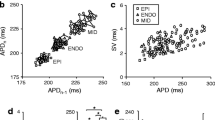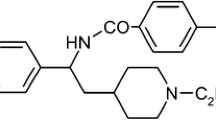Summary
Conventional microelectrode techniques were used to examine whether or not nicorandil, which shortens action potential duration (APD), modifies the lidocaine- or disopyramide-induced time-dependent reduction of V max in guinea-pig papillary muscles. First, effects of 0.1 and 1 mmol/l nicorandil were examined on the frequency dependence of V max and on the recovery process of V max. Second, the frequency-dependent reduction of V max by 20 μmol/l antiarrhythmic drugs was examined in the presence and absence of 1 mmol/l nicorandil at stimulation frequencies of 1/120 Hz–5 Hz. Third, the recovery process of V max in the presence of 20 μmol/l antiarrhythmic drugs was examined, with and without 1 mmol/l nicorandil, by applying test stimuli at various diastolic intervals after conditioning stimuli. 1 mmol/l nicorandil greatly shortened APD90 to 30–40% of control without changing the frequency dependence of V max, the recovery process of V max, and the resting potential. The lidocaine-induced, frequency-dependent reduction of V max was significantly antagonised by 1 mmol/l nicorandil, but the disopyramide-induced reduction was not. The recovery process of V max slowed in the presence of lidocaine was antagonised by 1 mmol/l nicorandil as follows: the time to get the full recovery of V max was shortened by nicorandil with a significant decrease in the zero time-intercept (from 0.54 to 0.38) but with an insignificant change in the recovery time constant (from 130 ms to 121 ms). In contrast, the recovery process of V max slowed in the presence of disopyramide (a zero time intercept of 0.13 and a recovery time constant of 50 s) was not significantly antagonised by 1 mmol/l nicorandil. In conclusion, nicorandil having an action potential-shortening action antagonises the lidocaine-induced, time-dependent reductions of V max, but not the disopyramide-induced reductions. These results suggest that: (1) lidocaine and disopyramide preferentially bind to inactivated and activated sodium channels, respectively, because lidocaine's effects are dependent on and disopyramide's effects are independent of APD (during which sodium channels are in the inactivated state); and (2) nicorandil is a useful drug for estimating whether a sodium channel-blocking action of class I antiarrhythmic drugs is due to an inactivated channel block or an activated channel block. These time-dependent reductions of V max by both lidocaine and disopyramide were well simulated by the guarded receptor hypothesis.
Similar content being viewed by others
References
Ban T (1977) A kinetic study of effects of propranolol and N-propylajmaline on the rate of rise of action potential in guinea pig papillary muscles. Jpn J Pharmacol 27:865–880
Bean BP, Cohen CJ, Tsien RW (1983) Lidocaine block of cardiac sodium channels. J Gen Physiol 81:613–642
Bigger JT, Hoffman BF (1985) Antiarrhythmic drugs. In: Gilman AG, Goodman LS, Rall TW, Murad F (eds) Goodman and Gilman's The pharmacological basis of therapeutics, Seventh ed. Macmillan, New York, pp 748–783
Borchard U, Hafner D, Ewerbeck S (1985) Electrophysiological and antiarrhythmic actions of tocainide in isolated heart preparations of the guinea pig. Arzneimittelforschung 35:1367–1374
Campbell TJ (1983) Importance of physico-chemical properties in determining the kinetics of the effects of class I antiarrhythmic drugs on maximum rate of depolarization in guinea-pig ventricle. Br J Pharmacol 80:33–40
Catterall WA (1980) Neurotoxins that act on voltage-sensitive sodium channels in excitable membranes. Annu Rev Pharmacol Toxicol 20:15–43
Chen C-M, Gettes LS, Katzung BG (1975) Effect of lidocaine and guinidine on steady-state characteristics and recovery kinetics of (dV/dt)max in guinea pig ventricular myocardium. Circ Res 37:20–29
Cohen CJ, Bean BP, Tsien RW (1984) Maximal upstroke velocity as an index of available sodium conductance. Comparison of maximal upstroke velocity and voltage clamp measurements of sodium current in rabbit Purkinje fibers. Circ Res 54:636–651
Cohen IS, Datyner NB, Gintant GA, Mulrine NK, Pennefather P (1985) A note on the relation of maximum upstroke velocity to peak inward current recorded by the voltage clamp. Ore Res 57:482–484
Courtney KR (1980) Interval-dependent effects of small antiarrhythmic drugs on excitability of guinea-pig myocardium. J Mol Cell Cardiol 12:1273–1286
Courtney KR (1983) Quantifying antiarrhythmic drug blocking during action potentials in guinea-pig papillary muscle. J Mol Cell Cardiol 15:749–757
Courtney KR (1985) Additional comments on Circ. Res. 54:636–651, 1984. Circ Res 57:194–195
Grant AO, Starmer CF, Strauss HC (1984) Antiarrhythmic drug action. Blockade of the inward sodium current. Circ Res 55:427–439
Hauswirth O, Singh BN (1979) Ionic mechanisms in heart muscle in relation to the genesis and the pharmacological control of cardiac arrhythmias. Pharmacol Rev 30:5–63
Heistracher P (1971) Mechanism of action of antifibrillatory drugs. Naunyn-Schmiedeberg's Arch Pharmacol 269:199–212
Hille B (1977) Local anesthetics: Hydrophilic and hydrophobic pathways for the drug-receptor reaction. J Gen Physiol 69: 497–515
Hodgkin AL, Huxley AF (1952) A quantitative description of membrane current and its application to conduction and excitation in nerve. J Physiol (Lond) 117:500–544
Hondeghem LM (1985) Comments on “Maximal upstroke velocity as an index of available sodium conductance: Comparison of maximal upstroke velocity and voltage clamp measurements of sodium current in rabbit Purkinje fibers” which appeared in Circ. Res. 54:636–651, 1984. Circ Res 57:192–193
Hondeghem LM, Katzung BG (1977) Time- and voltage-dependent interactions of antiarrhythmic drugs with cardiac sodium channels. Biochim Biophys Acta 472:373–398
Hondeghem LM, Katzung BG (1984) Antiarrhythmic agents: The modulated receptor mechanism of action of sodium and calcium channel-blocking drugs. Annu Rev Pharmacol Toxicol 24: 387–423
Hooke R, Jeeves TA (1961) ‘Direct search’ solution of numerical and statistical problems. J Assoc Comp Mach 8:212–229
Imanishi S, Arita M, Kiyosue T, Aomine M (1983) Effects of SG-75 (nicorandil) on electrical activity of canine cardiac Purkinje fibers: Possible increase in potassium conductance. J Pharmacol Exp Ther 225:198–205
Kakei M, Yoshinaga M, Saito K, Tanaka H (1986) The potassium current activated by 2-nicotinamidoethyl nitrate (nicorandil) in single ventricular cells of guinea pigs. Proc R Soc Lond 229:331–343
Kohlhardt M, Fröbe U, Herzig JW (1986) Modification of single cardiac Na+ channels by DPI 201–106. J Membr Biol 89:163–172
Kojima M, Ichiyama M, Shingai R, Ban T (1986) Effects of nicorandil, having an action potential shortening action, on lidocaine- and disopyramide-induced V max block of action potentials in guinea pig papillary muscles. Folia Pharmacol Japon 87:127P
Kodama I, Toyama J, Takanaka C, Yamada K (1987) Block of activated and inactivated sodium channels by class-I antiarrhythmic drugs studied by using the maximum upstroke velocity (V max) of action potential in guinea-pig cardiac muscles. J Mol Cell Cardiol 19:367–377
Matsubara T, Clarkson C, Hondeghem L (1987) Lidocaine blocks open and inactivated cardiac sodium channels. Naunyn-Schmiedeberg's Arch Pharmacol 336:224–231
Oshita S, Sada H, Kojima M, Ban T (1980) Effects of tocainide and lidocaine on the transmembrane action potentials as related to external potassium and calcium concentrations in guinea-pig papillary muscles. Naunyn-Schmiedeberg's Arch Pharmacol 314:67–82
Roden DM, Hoffman BF (1985) Action potential prolongation and induction of abnormal automaticity by low quinidine concentrations in canine Purkinje fibers. Relationship to potassium and cycle length. Circ Res 56:857–867
Sanchez-Chapula J, Tsuda Y, Josephson IR (1983) Voltage- and use-dependent effects of lidocaine on sodium current in rat single ventricular cells. Circ Res 52:557–565
Singh BN, Collett JT, Chew CYC (1980) New perspectives in the pharmacologic therapy of cardiac arrhythmias. Prog Cardiovase Dis 22:243–301
Starmer CF, Courtney KR (1986) Modeling ion channel blockade at guarded binding sites: application to tertiary drugs. Am J Physiol251:H848-H856
Starmer CF, Grant AO (1985) Phasic ion channel blockade. A kinetic model and parameter estimation procedure. Mol Pharmacol 28:348–356
Starmer CF, Grant AO, Strauss HC (1984) Mechanisms of use-dependent block of sodium channels in excitable membranes by local anesthetics. Biophys J 46:15–27
Vaughan Williams EM (1975) Classification of antidysrhythmic drugs. Pharmacol Ther B1:115 -138
Wang GK, Brodwick MS, Eaton DC (1985) Removal of sodium channel inactivation in squid axon by the oxidant chloramine-T. J Gen Physiol 86:289–302
Yamaoka K, Tanigawara Y, Nakagawa T, Uno T (1981) A pharmacokinetic analysis program (MULTI) for microcomputer. J Pharm Dyn 4:879–885
Yanagisawa T, Taira N (1980) Effect of 2-nicotinamidethyl nitrate (SG-75) on the membrane potential of left atrial muscle fibres of the dog. Increase in potassium conductance. Naunyn-Schmiedeberg's Arch Pharmacol 312:69–76
Yanagisawa T, Taira N (1981) Effect of 2-nicotinamidethyl nitrate (SG-75) on membrane potentials of canine Purkinje fibers. Jpn J Pharmacol 31:409–417
Yatani A, Akaike N (1985) Blockage of the sodium current in isolated single cells from rat ventricle with mexiletine and disopyramide. J Mol Cell Cardiol 17:467–476
Author information
Authors and Affiliations
Additional information
Send offprint requests to M. Kojima
Rights and permissions
About this article
Cite this article
Kojima, M., Ban, T. Nicorandil shortens action potential duration and antagonises the reduction of V max by lidocaine but not by disopyramide in guinea-pig papillary muscles. Naunyn-Schmiedeberg's Arch Pharmacol 337, 203–212 (1988). https://doi.org/10.1007/BF00169249
Received:
Accepted:
Issue Date:
DOI: https://doi.org/10.1007/BF00169249




